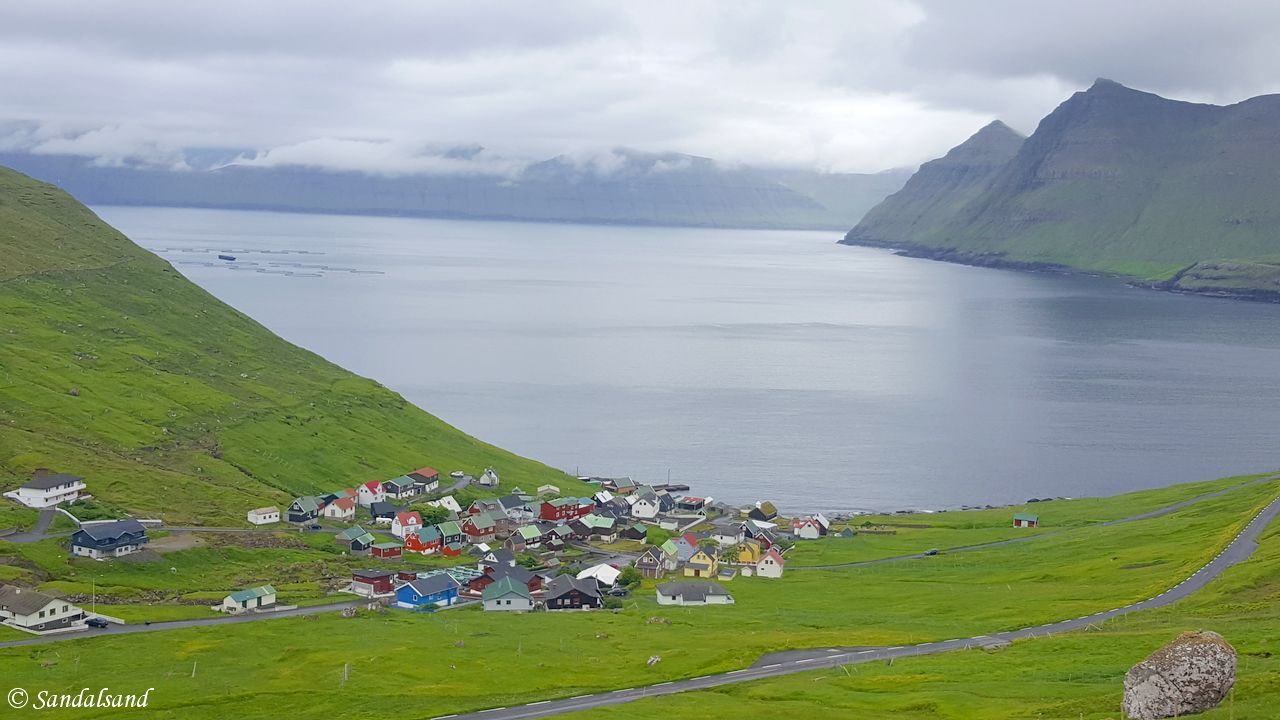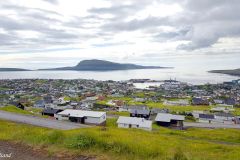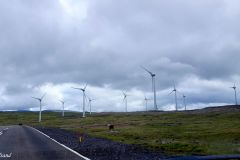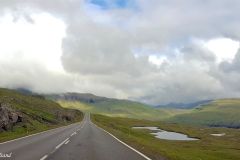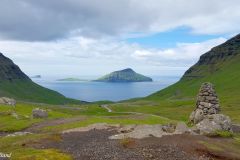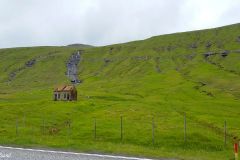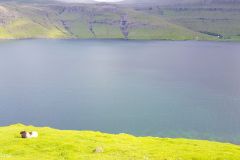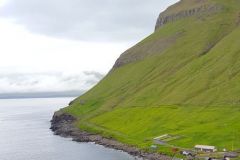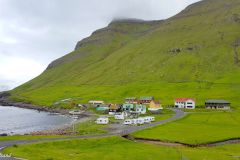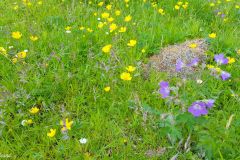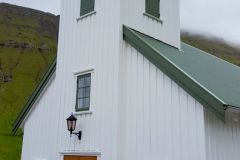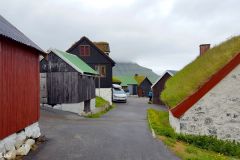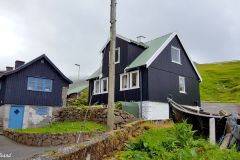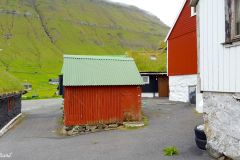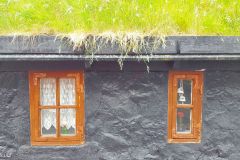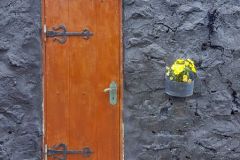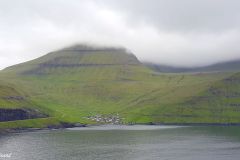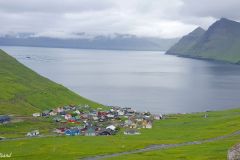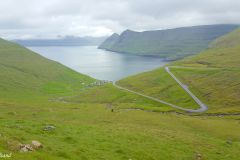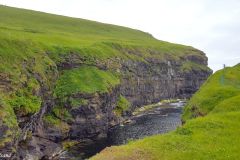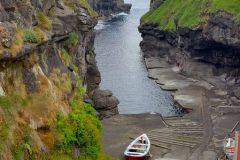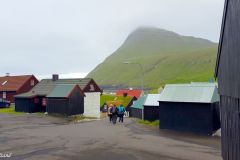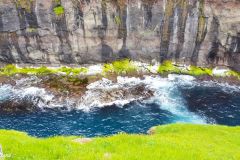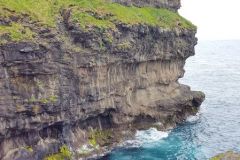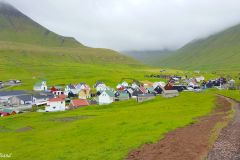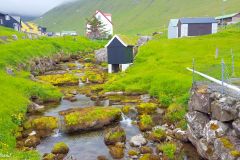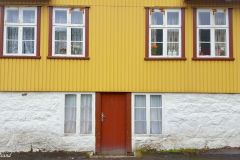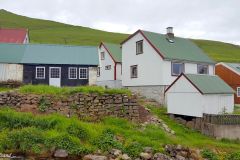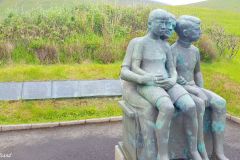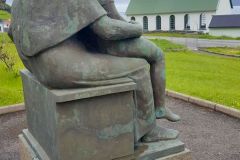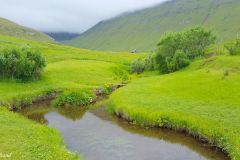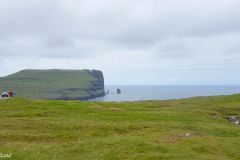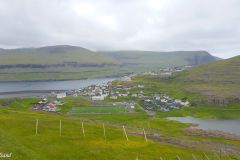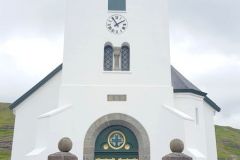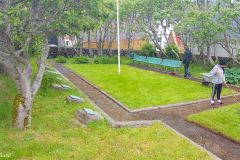Find attractions on Eysteroy, Borðoy and Viðoy islands in this first of two articles from a road trip on the Faroe Islands. It covers the northeastern islands which are reachable without having to take a ferry. The next article will cover the islands of Streymey and Vágar to the west.
All articles from this Faroes series are listed at the bottom along with a map. This might be handy to consult – and even to bring along – on your own trip to this beautiful archipelago in the North Atlantic Ocean. I spent four full days in the Faroes, but I had working camera equipment only half the time. The beginning of this article has no illustrations.
Viðareiði
Before arriving in the Faroes I had this idea of at least visiting one extremity and I found it here. Viðareiði is simply the northernmost settlement in the Faroe Islands and lies on the island of Viðoy. The place consists of a few farms and other buildings on a low-lying strip of farm land nestled east-west between two huge mountains. There is no definite centre structure. The population hovers around 350. Driving here from Tórshavn will take you about 1.5 hrs.
We find the church by the seashore on the western side. In the late 17th century a storm ruined the church and graveyard. Some coffins were washed to sea and drifted to the village of Hvannasund. There they were picked up and moved back to Viðareiði to be reburied.
This is a fine place to visit, if only to breathe the atmosphere of remoteness and wonder what makes people settle and live in places like this. Hikers may want to hire a guide and climb Mount Enniberg (750 m), one of the highest promontories in the world.
Viðareiði has raised some of the best mountain hikers, farmers, fishermen and hunters in the Faroe Islands, and the people of Viðareiði have a strong bond with the nature that surrounds them. (Source)
.
I’m not at all surprised.
I lunched at Hjá Elisabeth with an unusual tasting experience: Guillemot. I included my recommendation in the introduction article to the Faroes.
Some drivers will find excitement in getting to Viðareiði and back: Coming from the west, there is first a sub-sea tunnel (6,3 km) between Eysteroy and Borðoy. On the island of Borðoy you will have to navigate through two single lane tunnels, the Árnafjarðartunnilin (1.7 km) and the Hvannasundstunnilin (2.1 km) with no lights except the headlamps of your own vehicle. There are several passing places inside the tunnels, but take care. Drivers and passengers should leave their claustrophobia at home.
I have no images to show from the islands of Borðoy and Viðoy. The following selection is from the trip north from Tórshavn on road no 10.
Klaksvík
Viðareiði is at the far end of the northernmost island in the Faroes. Klaksvík is the second largest town in the country, situated on Borðoy, closer to Tórshavn. You will in other words pass through Klaksvík on your way to Viðareiði. The aforementioned 6,3 km sub-sea tunnel from Eysteroy pops into the day very close to the centre of town. Beneath high mountains two inlets meet on a strip of land almost dividing Borðoy and this is where the town is situated.
Being such an important junction Klaksvik prospered as a commercial and industrial centre for the northern islands over the years. The harbour reveals that the fishing industry is important. In addition the most popular beer on the islands, the Føroya Bjór, is brewed here. Today Klaksvík has a population of about 4,600.
This is a town with no particular charm, it is perhaps too active. To me Klaksvík stands out as interesting because it was here I first discovered the Faroese practice of commemorating those who have died at sea. Deceased persons are normally buried in marked graves in a cemetery, near a church. What if lives have been lost at sea, out fishing, in a storm – and the body has disappeared? The tradition in the towns and villages of the Faroes is to make a small square, perhaps making it look like garden with trees and bushes around. Here a number of memorial plaques of bronze are set up. They all have engraved the name of the vessel, date of accident, name of person and age. It is particularly moving to notice a long list of names, some very young.
Elduvík
We are now on the island of Eysteroy. If you have ever come across pictures from the Faroe Islands, with a small village set beneath a towering mountain, Elduvík may well have been it. The population is around 30, but some of the houses are evidently rental objects. This is a delightful little place with a small church, like every other Faroese village. The people on the islands are very religious.
If you choose to spend the night here, it will be for reasons of relaxation.
Funningur
Driving along the Funningsfjørdur to and from Elduvík we will have a view of the village of Funningur on the opposite side. It looks larger than Elduvík, and has indeed a population of 56. Seen from across the fjord it seems to have an even more dramatic setting. The highest mountain in the Faroe Islands, the Slættaratindur (880 m), rise high above it.
The main road does not go into the village itself but meanders up the mountainside. Eventually it meets a reasonably flat moorland only to descend to the most visited tourist attraction in the Faroes.
Gjógv
This is as far north you get on the island of Eysturey, about an hour drive from Tórshavn. This is what the tourist information writes:
With less than 50 inhabitants, all living in old timber-walled and turf-roofed cottages, Gjógv has an abundance of charm and appeal. Add to this some great hiking and walking trails that offer spectacular views of the North Atlantic and the surrounding islands and you won’t want to miss out on this special location.
And it is all correct. Save the fact that this does not come unnoticed by anyone visiting the Faroe Islands.
The main attraction, which has given its name to the village, is the 200-metre long sea-filled gorge that runs straight into the village from the sea. The cliffs on either side are dramatic. The idea of pulling fishing boats in and up into a secure place is good. In addition the red- or black-painted turf-roofed houses are lovely.
My suggestion is to take a walk across the stream to the memorial site for the deceased at sea. There are more serious hikes around as well, depending on time and your priorities. I lunched at the modern Gjáargarður guesthouse which did not leave a lasting culinary impression. The view was good though.
Eiði
From Gjógv we head back a few kilometres and then turn west to the north-western tip of the Eysturoy. Make sure to make a stop for a panoramic view of Eiðiskollur promontory and the two cliffs at the bottom it. They are called Risin and Kellingin – the giant and the witch, and there is a legend about them:
When the giant and the witch, perhaps Faroe Islands first tourists, decided to haul the Faroe Islands back home to Iceland, they put a rope around the Eiðiskollur mountain. They forgot the time as they pulled and tugged and as the sun’s first rays shone on them, they turned to stone. (Tourist guide)
On your way down to Eiði take notice of the football field very close to the ocean. They love football in the Faroes. This village, or small town, of about 620 inhabitants does not offer any special attraction apart from itself. I parked by the church (anno 1881) and walked into the village. Soon I noticed that the memorial garden was tended by local teenagers. This was obviously some kind of summer job. I had an apple pie in a café and enjoyed the sun.
What to explore on the Faroes?
Explore the map below. You may zoom in and out, click the markers for some more information. I made it before going to the islands and then added more sites and attractions as my four days and nights in 2016 went by.
A bit of practical advice: Ferry services connect the Faroes with Denmark and Iceland so it is possible to bring your own car. I flew in and had booked a car at the airport. This worked fine. Roads are overall of a good standard and well sign-posted. You will navigate by a good map (GPS/smartphone/paper) and distances are not long. I stayed my four nights in Tórshavn taking day-trips into the peripheries. This increased the total distance covered, but as the map shows – driving 300-400 km in the course of two-three days is piece of cake.
Lexical information about the archipelago is found on Wikipedia. Tourist information is available at Visit Faroe Islands, Faroe Islands Tourist Guide, and on international websites like Lonely Planet and Wikitravel. An introduction to all villages is found here.
This series from the Faroe Islands consists of several posts.
(1) Introduction
(2) Tórshavn, the nicest little capital in the world
(3) Medieval Faroese history at Kirkjubøur
(4) A boat trip to Hestur, Koltur and a concert in the caves
(5) Attractions on Eysteroy, Borðoy and Viðoy islands (THIS)
(6) Attractions on Streymey and Vágar islands
There is also a video from this visit in 2016.

